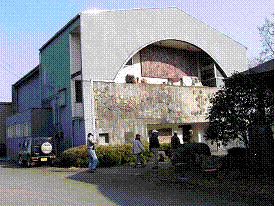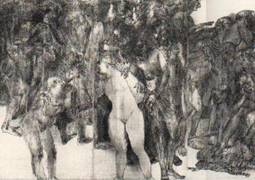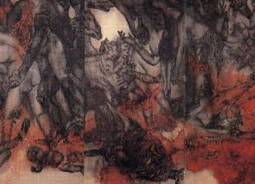�@
�@
|
7 Genbaku-no-zu |
�@
| �@�@At |
| �@�@Maruki Iri (�ۖ@�ʗ�) was
born in Hiroshima. He became
a painter and married Toshi (�r) in 1941. She
was also a painter. They
lived in |
| �@�@Three years passed and they began to paint what they
saw in
Hiroshima
.
By painting the pictures, they prayed for the dead.
They hoped strongly that it would never happen again.
It took over 30 years for them to finish painting the series
about |
 |
�@
 |
The Panels travel around the world and exhibitions are
held in many countries. The
pictures deeply move and impress people all over the world.
They are usually displayed in the Maruki Gallery in
Higashimatsuyama, Saitama. Iri
died in 1995. Toshi died in
2000. But their wish for
peace is taking over even now and will continue forever.
(296��) |
�@
�@
|
atomic bomb ���q���e burnt < burn �R���� destroy �j�� marry �������� niece �߂� suffer burns�@ �₯�ǂ� ( suffer �ꂵ�� ) victim �]���� pray �F�� strongly ���� happen�@�N���� series�@�V���[�Y���� panel ��� stupid ������ exhibition �W���� held < hold �Â��A�s�� deeply�@�[�� move ���������� display �W������ gallery ���p�ف@ continue ���� take over �p�� forever �i���� |
�@
�@
�@
![]()
�@
�@
|
|
||
| Misaki: | This is the Maruki Gallery. It has �gGenbaku-no-zu�h. |

|
| Let�fs go and see it. | ||
| John: | Yes, let�fs. | |
| Misaki: | This is the first part named �g Ghosts �h. This picture was painted in | |
| 1950. In those days |
||
| difficult to present their works then. And the picture was so | ||
| shocking to people. | ||
| John: | I see. | |
| Misaki: | This picture showed a lot of people who became like ghosts because |

|
| of burns. All their clothing burned off at once. | ||
| John: | I can�ft believe it. I am really shocked. It�fs just like hell. | |
| Misaki: | Right. No one can imagine the scene. The second one is �gFire �h. | |
| The whole city burned up and people were also burned under the | ||
| big fire. People ran away from the fire and walked all around the | ||
| city to look for water, a last drop of water. | ||
| John: | Terrible. | |
| Will you tell me all the titles of the 15 parts of �gGenbaku-no-zu�h? | ||
| Misaki: | Sure. Look at this pamphlet. You can see them in it. | |
| Here you are. | ||
|
�T Ghosts�i�H��j�@�U Fire�i�j�@�V Water�i���j�@�W Rainbow�i���j�X Boys and Girls�i���N�����j �Y Atomic Desert�i���q��j�@�Z�@Bamboo Thicket�i�|��ԁj�@�[�@Rescue�i�~�o�j�@�\�@Yaizu�i�ĒÁj �] Petition�i�����j �]�T Mother and Child�i��q���j�@�]�U�@Floating Lanterns�i�Ƃ��낤�����j �]�V�@Death of American Prisoners of War�i�ĕ��ߗ��̎��j �]�W Crows�i���炷�j�]�X Nagasaki�i����j �@ |
|
|
||
| John: | Oh, thank you. |
|
| Misaki: | You�fre welcome. | |
| John: | I think it is important for us to remember what happened and | |
| never make war again. | ||
| Through the paintings Mr.&Mrs. Maruki teach us that peace is | ||
| important. | ||
| Misaki | I agree with you. Japanese people should tell the world about the | |
| horror of the A-bomb. We are the only people in the world that | ||
| experienced it. | ||
| John: | You�fre right. Today we thought of world peace. I had a very good | |
| time. | ||
|
occupy ��̂��� �@�@present ���\���� �@ clothing �g�ɂ�����́@hell �n�� �@�@drop ��H terrible �Ђǂ��@�@pamphlet �@�p���t���b�g fact ���� �@horror ���낵�� agree with�`�@�`�ɓ��ӂ��� �@�@peace�@���a |
�@
�@
�@
�@
�@